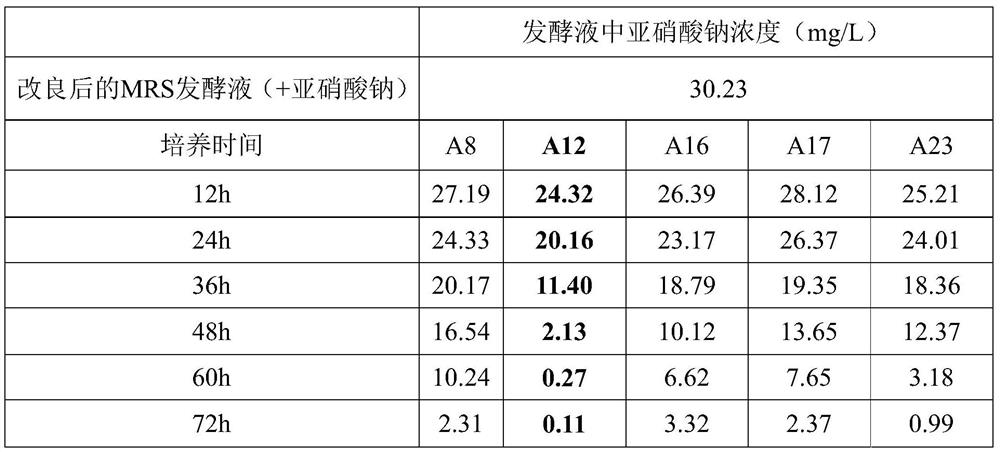Microecological compound premixed feed containing Pediococcus acidilactici and application thereof
A pre-mixed feed, Pediococcus lactis technology, applied in applications, microorganisms, animal feed, etc., can solve problems such as harm to human health, pathogenic bacteria resistance, etc., to reduce breeding diseases, superoxide dismutase and acid phosphatase activities. Improve and improve the effect of environmental water quality
- Summary
- Abstract
- Description
- Claims
- Application Information
AI Technical Summary
Problems solved by technology
Method used
Image
Examples
Embodiment 1
[0028] Embodiment 1: Isolation, screening and identification of strains
[0029] 1. Sample:
[0030] The intestines of live California perch were collected from a market in Jiaozhou City, Qingdao. Healthy and vigorous California perch intestines were extracted by aseptic operation for subsequent separation.
[0031] 2. Screening method
[0032] (1) Enrichment culture
[0033] Take the intestinal sample and put it into a grinder, put it into normal saline, homogenize it, and centrifuge at low speed, so that the bacteria in the sample are fully dispersed in the upper layer of normal saline, and then 10-fold gradient dilution. The above bacterial suspension was transferred to a liquid MRS medium with a 10% inoculum amount, and cultured at 30°C for 24h-48h to obtain an enriched bacterial suspension.
[0034] (2) Separation
[0035] Apply 0.2ml of bacterial suspension to DM solid medium plate by 10-fold dilution method, and cultivate in a 30°C incubator; when a single colony gr...
Embodiment 2
[0047] Application of embodiment 2 Pediococcus lactis MST02 in purifying aquaculture water
[0048] 1. Preparation of bacteria powder
[0049] Pediococcus lactis MST02 was expanded and cultivated to make 10 billion / g bacterial powder.
[0050] 2. Experimental location
[0051] A California perch breeding factory in Yancheng, Jiangsu.
[0052] 3. Experimental process
[0053] Six ponds with similar size and water quality were selected, three in each of the control group and the experimental group were paralleled, and the nitrite nitrogen content in each water body was detected respectively. Then add 10ppm of Pediococcus lactis powder to the water body of the experimental group, and do not add it to the control group. The water temperature in the experiment was 28-30°C, and the same equipment was used to continuously aerate the water body during the experiment. After 48 hours, the content of nitrite nitrogen in the water body was measured respectively, and the detection val...
Embodiment 3
[0058] Embodiment 3 Pediococcus lactis MST02 stomach acid resistance test
[0059] The simulated gastric juice components are: tryptone 8.5g, glucose 3.5g, sodium chloride 2.05g, calcium chloride 0.13g, potassium chloride 0.42g, potassium dihydrogen phosphate 0.55g, ox bile salt 0.05g, lysozyme 0.11g, Pepsin 13.5g, distilled water 1000ml, hydrochloric acid to adjust the pH to 1.5 and 2.5 respectively, and sterilize at 115°C for 20 minutes.
[0060] Another strain of Pediococcus lactis AS1.2696 was selected as the experimental control group from the Institute of Microbiology, Chinese Academy of Sciences.
[0061] Activate Pediococcus lactis MST02 and Pediococcus lactis AS1.2696 under the same conditions, then transfer it into 100ml MRS liquid medium according to the inoculum size of 0.6%, culture at 30°C for 24 hours, and add the two bacterial solutions to the prepared aseptic mock Gastric juice, after 0h and 2h, the number of viable bacteria was detected by plate counting met...
PUM
 Login to View More
Login to View More Abstract
Description
Claims
Application Information
 Login to View More
Login to View More - R&D
- Intellectual Property
- Life Sciences
- Materials
- Tech Scout
- Unparalleled Data Quality
- Higher Quality Content
- 60% Fewer Hallucinations
Browse by: Latest US Patents, China's latest patents, Technical Efficacy Thesaurus, Application Domain, Technology Topic, Popular Technical Reports.
© 2025 PatSnap. All rights reserved.Legal|Privacy policy|Modern Slavery Act Transparency Statement|Sitemap|About US| Contact US: help@patsnap.com



